Performance and Intrusiveness of Crowdshipping Systems: An Experiment with Commuting Cyclists in The Netherlands
Abstract
1. Introduction
2. Literature Review
3. Case Study
3.1. Crowdsourced Systems
3.2. Route Selection and Parcel Design
3.3. Scenario Design
3.3.1. Scenario 1
3.3.2. Scenario 2
4. Results and Discussion
4.1. Indicators
4.1.1. Pass
4.1.2. Long-Wait
4.1.3. Turn-Around
4.1.4. Overlap
4.2. Results
4.3. Analysis and Findings
5. Conclusions
Author Contributions
Funding
Acknowledgments
Conflicts of Interest
References
- González-Sánchez, R.; Settembre-Blundo, D.; Ferrari, A.M.; García-Muiña, F.E. Main dimensions in the building of the circular supply chain: A literature review. Sustainability 2020, 12, 2459. [Google Scholar] [CrossRef]
- Li, X.; Kan, H.; Hua, X.; Wang, W. Simulation-Based Electric Vehicle Sustainable Routing with Time-Dependent Stochastic Information. Sustainability 2020, 12, 2464. [Google Scholar] [CrossRef]
- De Carvalho, N.L.; Vieira, J.G.V.; da Fonseca, P.N.; Dulebenets, M.A.J.S. A Multi-Criteria Structure for Sustainable Implementation of Urban Distribution Centers in Historical Cities. Sustainability 2020, 12, 5538. [Google Scholar] [CrossRef]
- Lang, W.; Jedermann, R.; Mrugala, D.; Jabbari, A.; Krieg-Brückner, B.; Schill, K. The “Intelligent Container”—A Cognitive Sensor Network for Transport Management. IEEE Sens. J. 2011, 11, 688–698. [Google Scholar] [CrossRef]
- Lin, X. Controlled Perishable Goods Logistics: Real-Time Coordination for Fresher Products. Ph.D. Thesis, Delft University of Technology, Delft, The Netherlands, 2019. [Google Scholar]
- Devari, A.; Nikolaev, A.G.; He, Q. Crowdsourcing the last mile delivery of online orders by exploiting the social networks of retail store customers. Transp. Res. Part E Logist. Transp. Rev. 2017, 105, 105–122. [Google Scholar] [CrossRef]
- Macrina, G.; Pugliese, L.D.P.; Guerriero, F. Crowd-shipping: A new efficient and eco-friendly delivery strategy. Procedia Manuf. 2020, 42, 483–487. [Google Scholar] [CrossRef]
- Marcucci, E.; Pira, M.L.; Carrocci, C.S.; Gatta, V.; Pieralice, E. Connected shared mobility for passengers and freight: Investigating the potential of crowdshipping in urban areas. In Proceedings of the 2017 5th IEEE International Conference on Models and Technologies for Intelligent Transportation Systems (MT-ITS), Naples, Italy, 26–28 June 2017; pp. 839–843. [Google Scholar]
- Chen, C.; Pan, S.; Wang, Z.; Zhong, R.Y. Using taxis to collect citywide E-commerce reverse flows: A crowdsourcing solution. Int. J. Prod. Res. 2017, 55, 1833–1844. [Google Scholar] [CrossRef]
- Arslan, A.M.; Agatz, N.; Kroon, L.; Zuidwijk, R. Crowdsourced Delivery—A Dynamic Pickup and Delivery Problem with Ad Hoc Drivers. Transp. Sci. 2019, 53, 222–235. [Google Scholar] [CrossRef]
- Ballot, E.; Gobet, O.; Montreuil, B. Physical Internet Enabled Open Hub Network Design for Distributed Networked Operations. In Service Orientation in Holonic and Multi-Agent Manufacturing Control; Borangiu, T., Thomas, A., Trentesaux, D., Eds.; Springer: Berlin/Heidelberg, Germany, 2012; pp. 279–292. [Google Scholar] [CrossRef]
- Hodson, H. Hand-delivered parcels find their way to you via the crowd. New Sci. 2013, 218, 17–18. [Google Scholar] [CrossRef]
- He, Z.; Haasis, H.-D. A Theoretical Research Framework of Future Sustainable Urban Freight Transport for Smart Cities. Sustainability 2020, 12, 1975. [Google Scholar] [CrossRef]
- Buldeo Rai, H.; Verlinde, S.; Merckx, J.; Macharis, C. Crowd logistics: An opportunity for more sustainable urban freight transport? Eur. Transp. Res. Rev. 2017, 9, 39. [Google Scholar] [CrossRef]
- Gatta, V.; Marcucci, E.; Nigro, M.; Patella, S.M.; Serafini, S. Public transport-based crowdshipping for sustainable city logistics: Assessing economic and environmental impacts. Sustainability 2019, 11, 145. [Google Scholar] [CrossRef]
- Rougès, J.-F.; Montreuil, B. Crowdsourcing delivery: New interconnected business models to reinvent delivery. In Proceedings of the 1st international physical internet conference, Quebec City, QC, Canada, 28 May 2014; pp. 1–19. [Google Scholar]
- Sadilek, A.; Krumm, J.; Horvitz, E. Crowdphysics: Planned and opportunistic crowdsourcing for physical tasks. In Proceedings of the 7th International AAAI Conference on Weblogs and Social Media, Cambridge, MA, USA, 8–11 July 2013; pp. 536–545. [Google Scholar]
- Le, T.V.; Stathopoulos, A.; Van Woensel, T.; Ukkusuri, S.V. Supply, demand, operations, and management of crowd-shipping services: A review and empirical evidence. Transp. Res. Part C Emerg. Technol. 2019, 103, 83–103. [Google Scholar] [CrossRef]
- Miller, J.; Nie, Y.; Stathopoulos, A. Crowdsourced urban package delivery: Modeling traverler willingness to work as crowdshippers. Transp. Res. Rec. 2017, 2610, 67–75. [Google Scholar] [CrossRef]
- Chi, P.-Y.; Batra, A.; Hsu, M. Mobile crowdsourcing in the wild: Challenges from a global community. In Proceedings of the 20th International Conference on Human-Computer Interaction with Mobile Devices and Services Adjunct, Barcelona, Spain, 5–8 October 2020; pp. 410–415. [Google Scholar]
- Le, T.V.; Ukkusuri, S.V. Modeling the willingness to work as crowd-shippers and travel time tolerance in emerging logistics services. Travel Behav. Soc. 2019, 15, 123–132. [Google Scholar] [CrossRef]
- Ermagun, A.; Stathopoulos, A. To bid or not to bid: An empirical study of the supply determinants of crowd-shipping. Transp. Res. Part A Policy Pract. 2018, 116, 468–483. [Google Scholar] [CrossRef]
- Frehe, V.; Mehmann, J.; Teuteberg, F. Understanding and assessing crowd logistics business models–using everyday people for last mile delivery. J. Bus. Ind. Mark. 2017, 32, 75–97. [Google Scholar] [CrossRef]
- Dablanc, L.; Morganti, E.; Arvidsson, N.; Woxenius, J.; Browne, M.; Saidi, N. The rise of on-demand ‘Instant Deliveries’ in European cities. Supply Chain Forum Int. J. 2017, 18, 203–217. [Google Scholar] [CrossRef]
- Punel, A.; Ermagun, A.; Stathopoulos, A. Studying determinants of crowd-shipping use. Travel Behav. Soc. 2018, 12, 30–40. [Google Scholar] [CrossRef]
- Chen, C.; Cheng, S.-F.; Lau, H.C.; Misra, A. Towards city-scale mobile crowdsourcing: Task recommendations under trajectory uncertainties. In Proceedings of the 24th International Joint Conference on Artificial Intelligence, Buenos Aires, Argentina, 25–31 July 2015; pp. 1113–1119. [Google Scholar]
- Setzke, D.S.; Pflügler, C.; Schreieck, M.; Fröhlich, S.; Wiesche, M.; Krcmar, H. Matching drivers and transportation requests in crowdsourced delivery systems. In Proceedings of the 23rd Americas Conference on Information systems, Boston, MA, USA, 10–12 August 2017; pp. 1–10. [Google Scholar]
- Buldeo Rai, H.; Verlinde, S.; Macharis, C. Shipping outside the box. Environmental impact and stakeholder analysis of a crowd logistics platform in Belgium. J. Clean. Prod. 2018, 202, 806–816. [Google Scholar] [CrossRef]
- Zheng, L.; Chen, L. Maximizing acceptance in rejection-aware spatial crowdsourcing. IEEE Trans. Knowl. Data Eng. 2017, 29, 1943–1956. [Google Scholar] [CrossRef]
- Gdowska, K.; Viana, A.; Pedroso, J.P. Stochastic last-mile delivery with crowdshipping. Transp. Res. Procedia 2018, 30, 90–100. [Google Scholar] [CrossRef]
- Kim, Y.; Gergle, D.; Zhang, H. Hit-or-Wait: Coordinating Opportunistic Low-effort Contributions to Achieve Global Outcomes in On-the-go Crowdsourcing. In Proceedings of the 2018 CHI Conference on Human Factors in Computing Systems, Montreal, QC, Canada, 21–26 April 2018; p. 96. [Google Scholar]
- Centraal Bureau voor de Statistiek. Transport and mobility Report; Centraal Bureau voor de Statistiek: The Hague, The Netherlands, 2016. [Google Scholar]
- Leitão, P.; Barbosa, J.; Trentesaux, D. Bio-inspired multi-agent systems for reconfigurable manufacturing systems. Eng. Appl. Artif. Intell. 2012, 25, 934–944. [Google Scholar] [CrossRef]
- Bartholdi, J.J.; Eisenstein, D.D.; Lim, Y.F. Self-organizing logistics systems. Annu. Rev. Control 2010, 34, 111–117. [Google Scholar] [CrossRef]

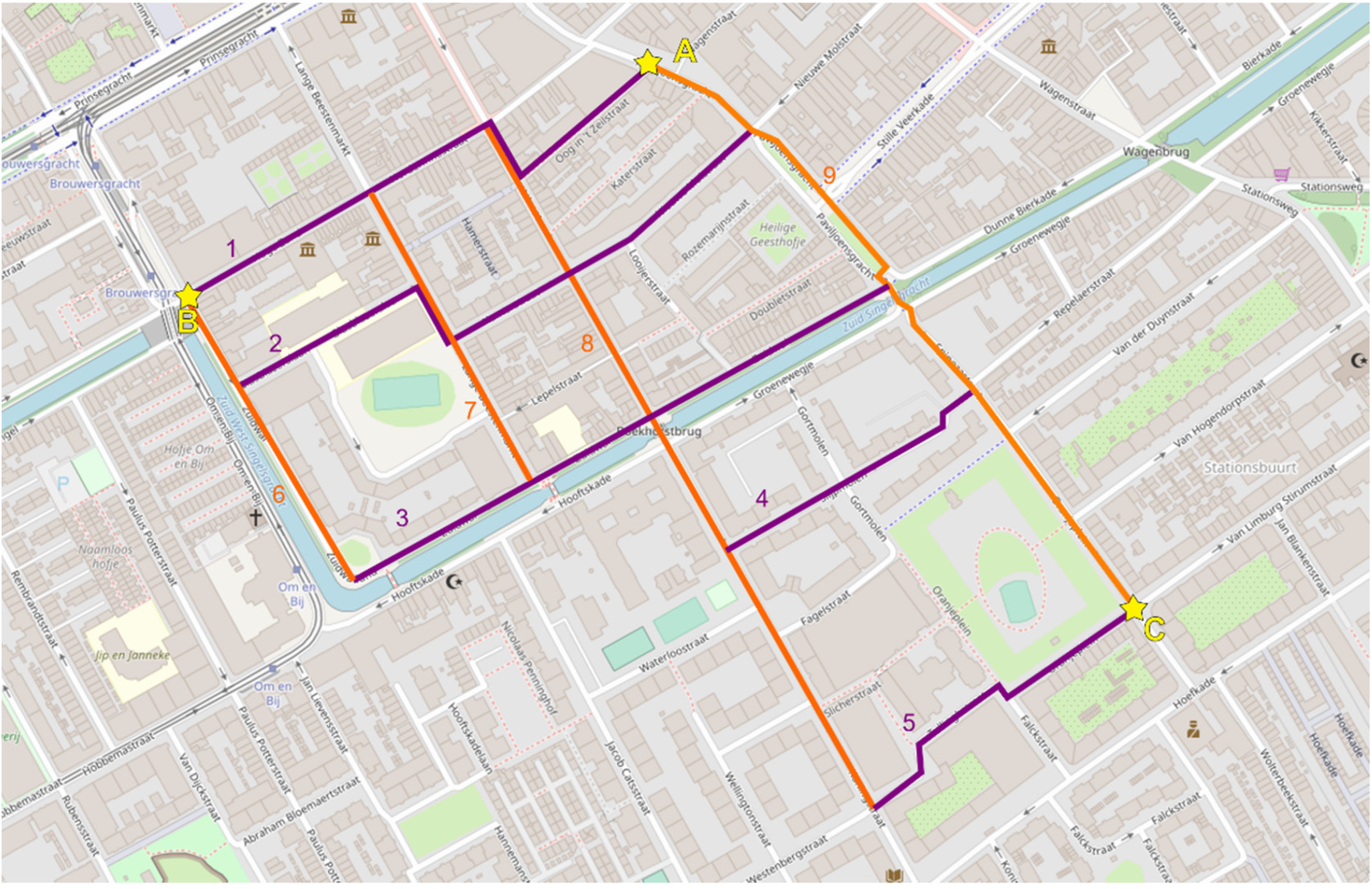
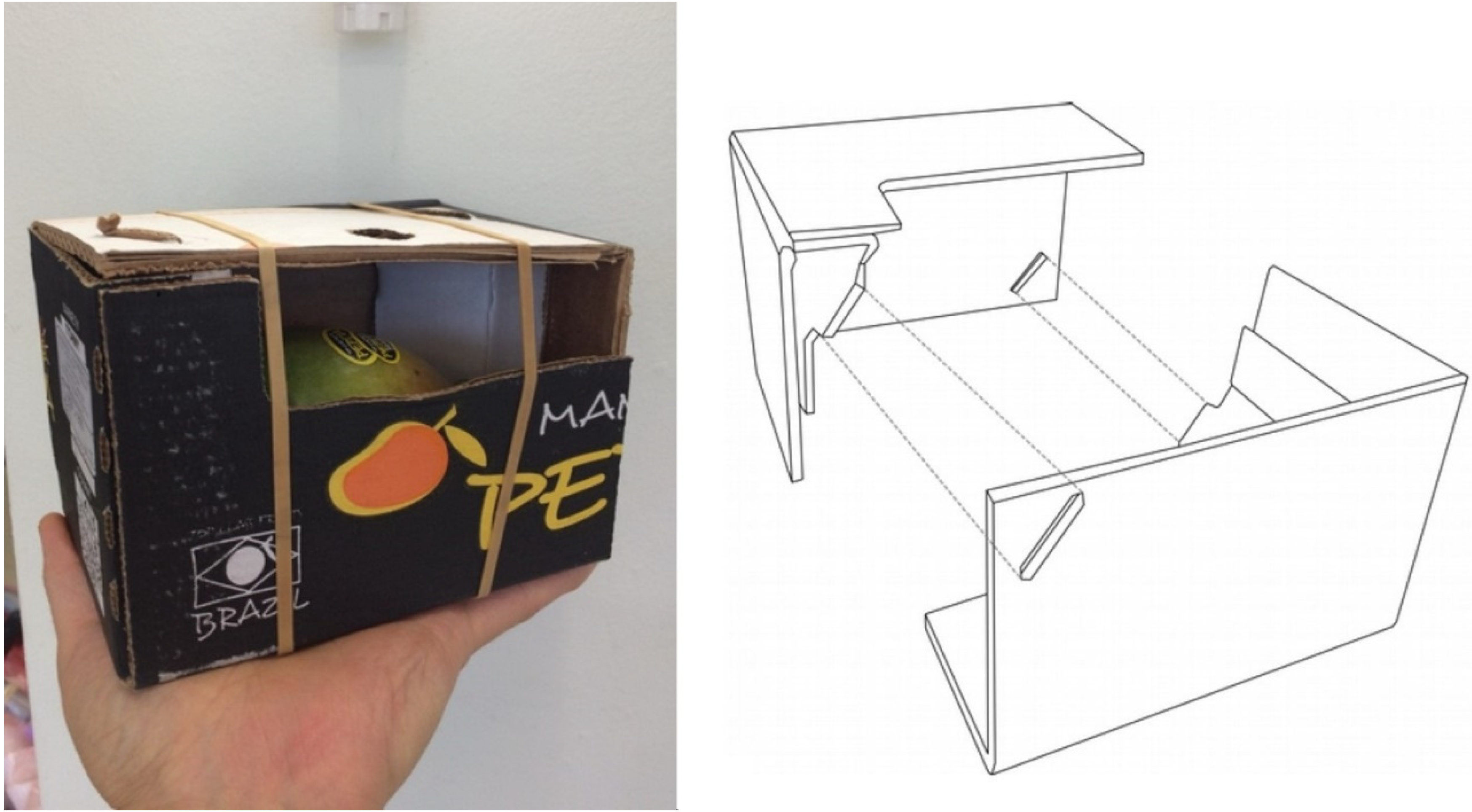
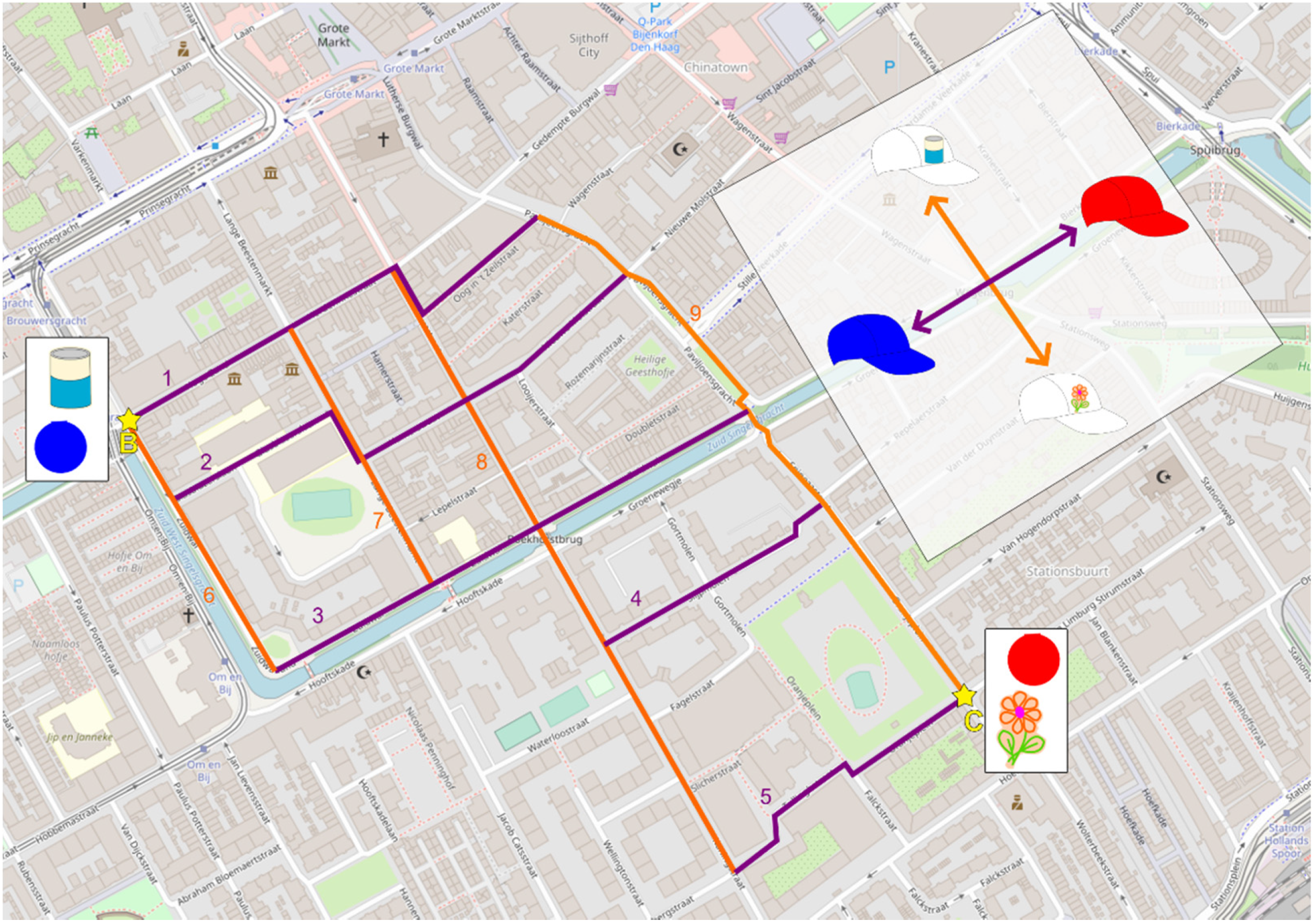
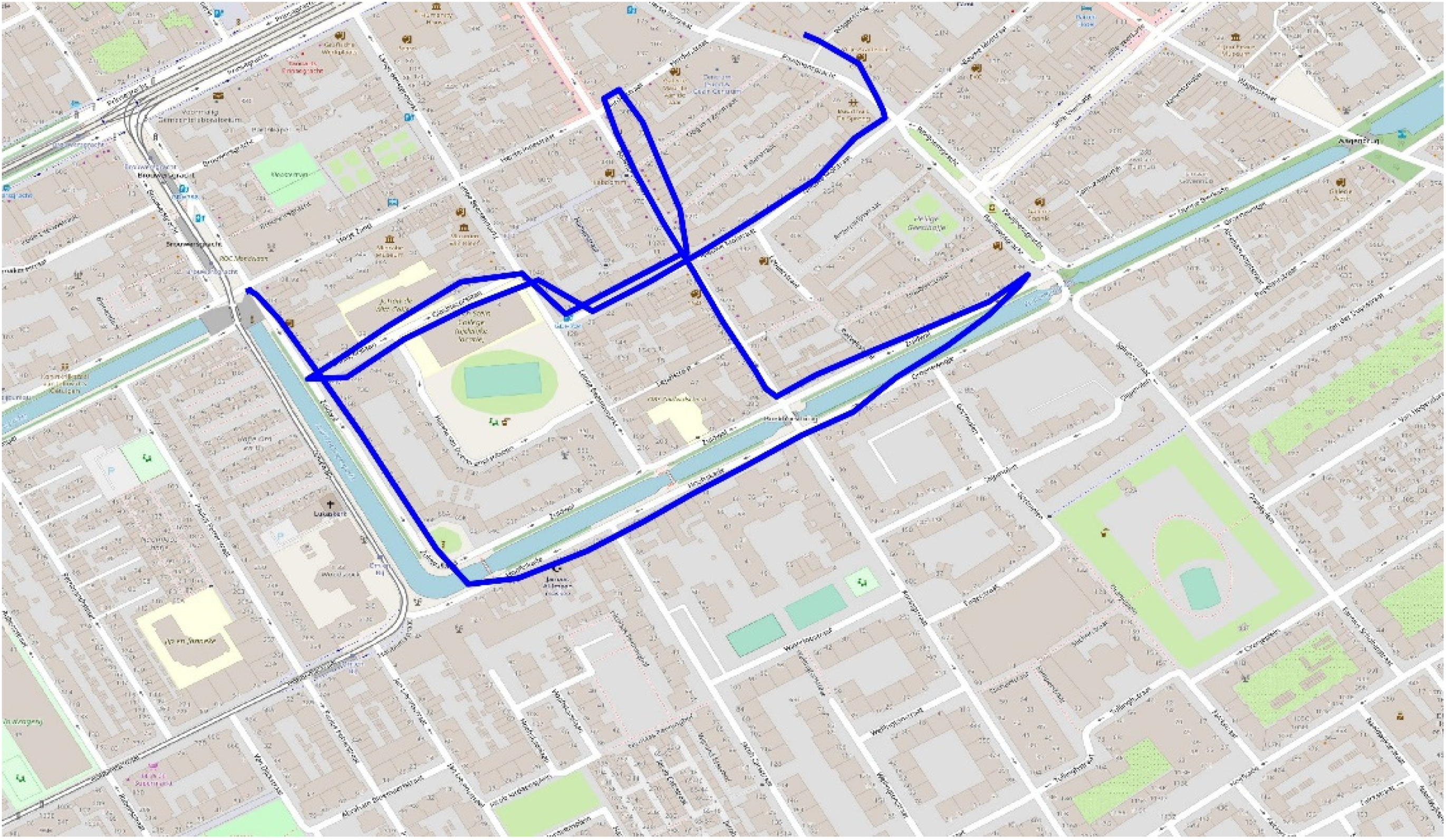
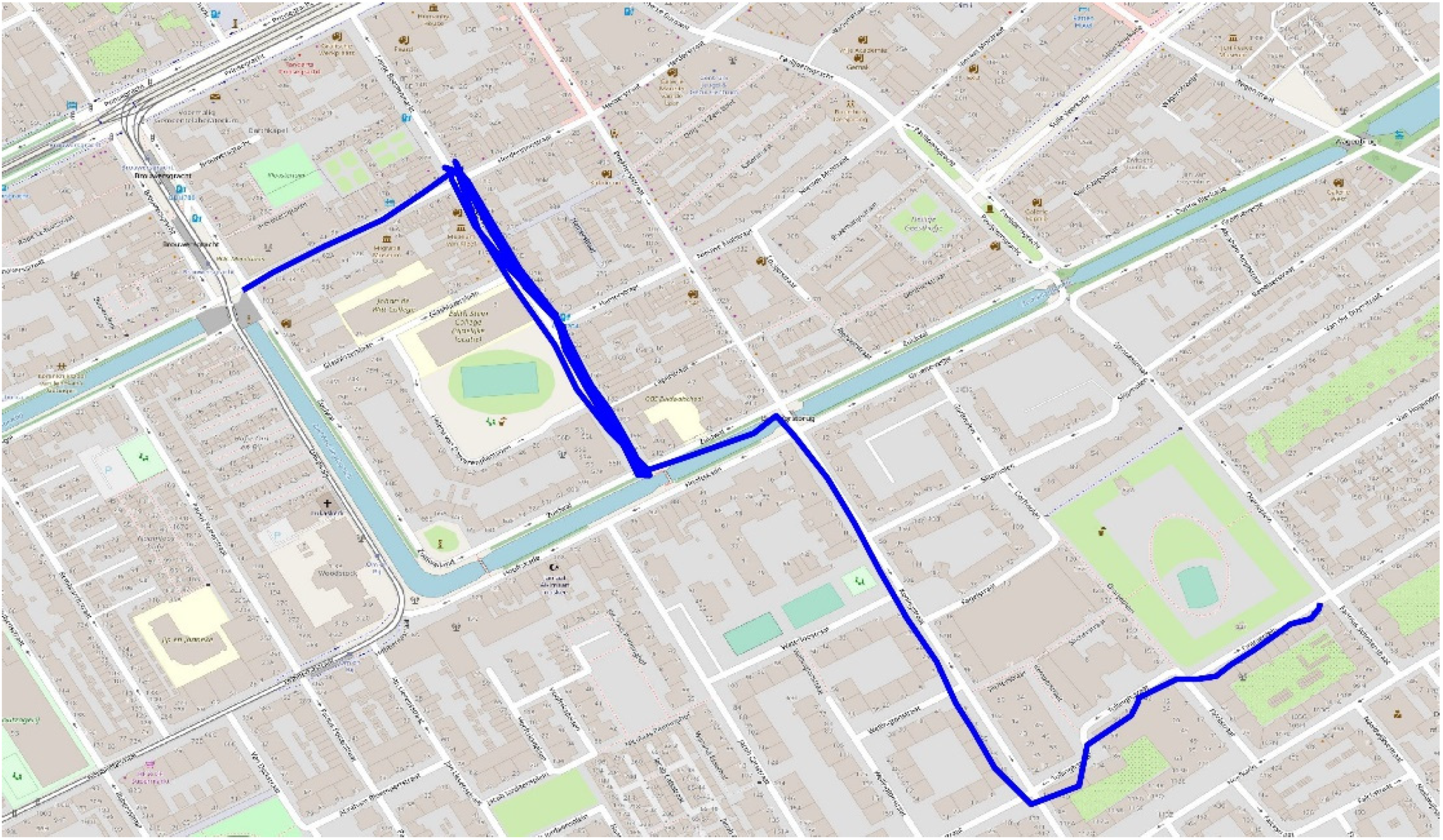

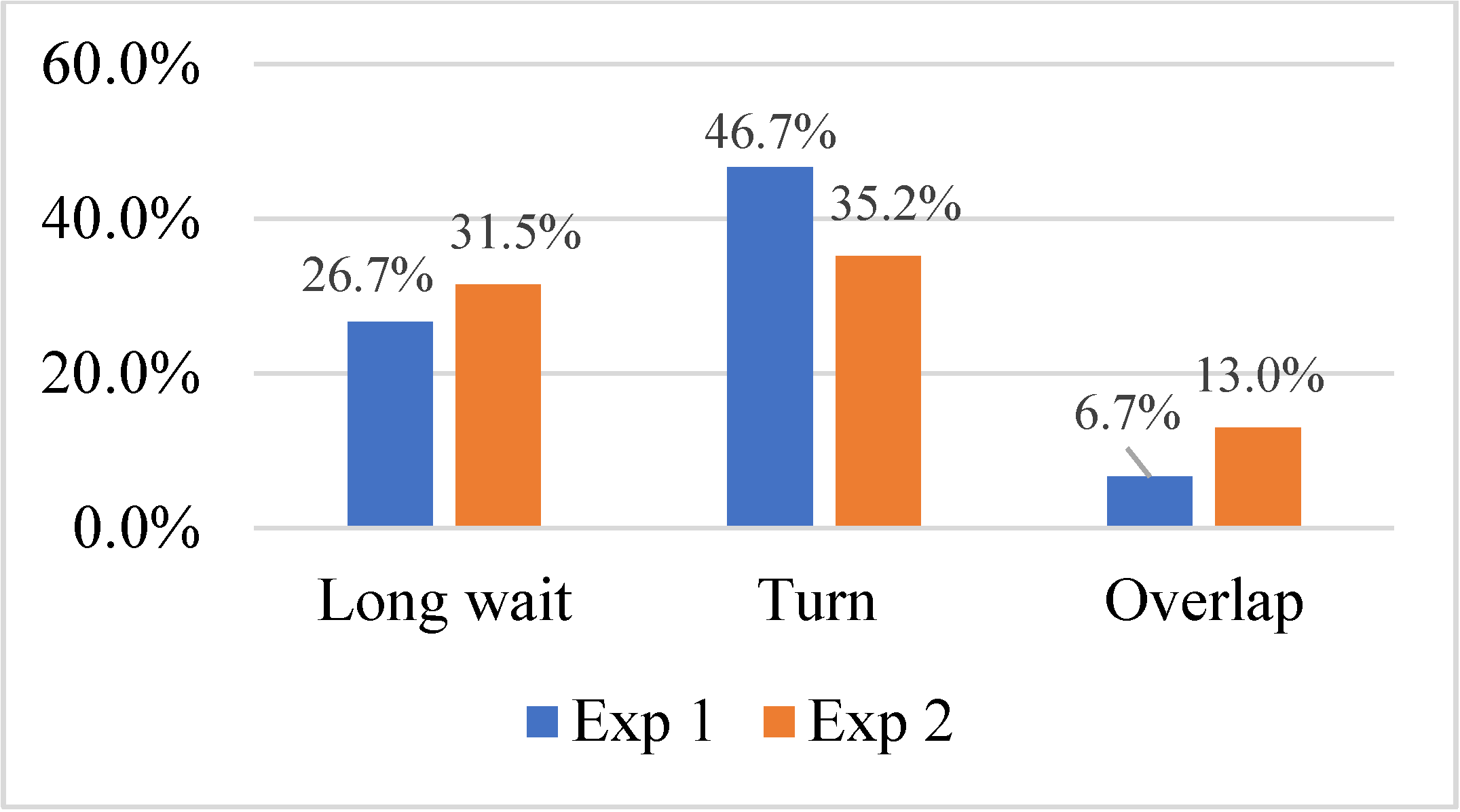
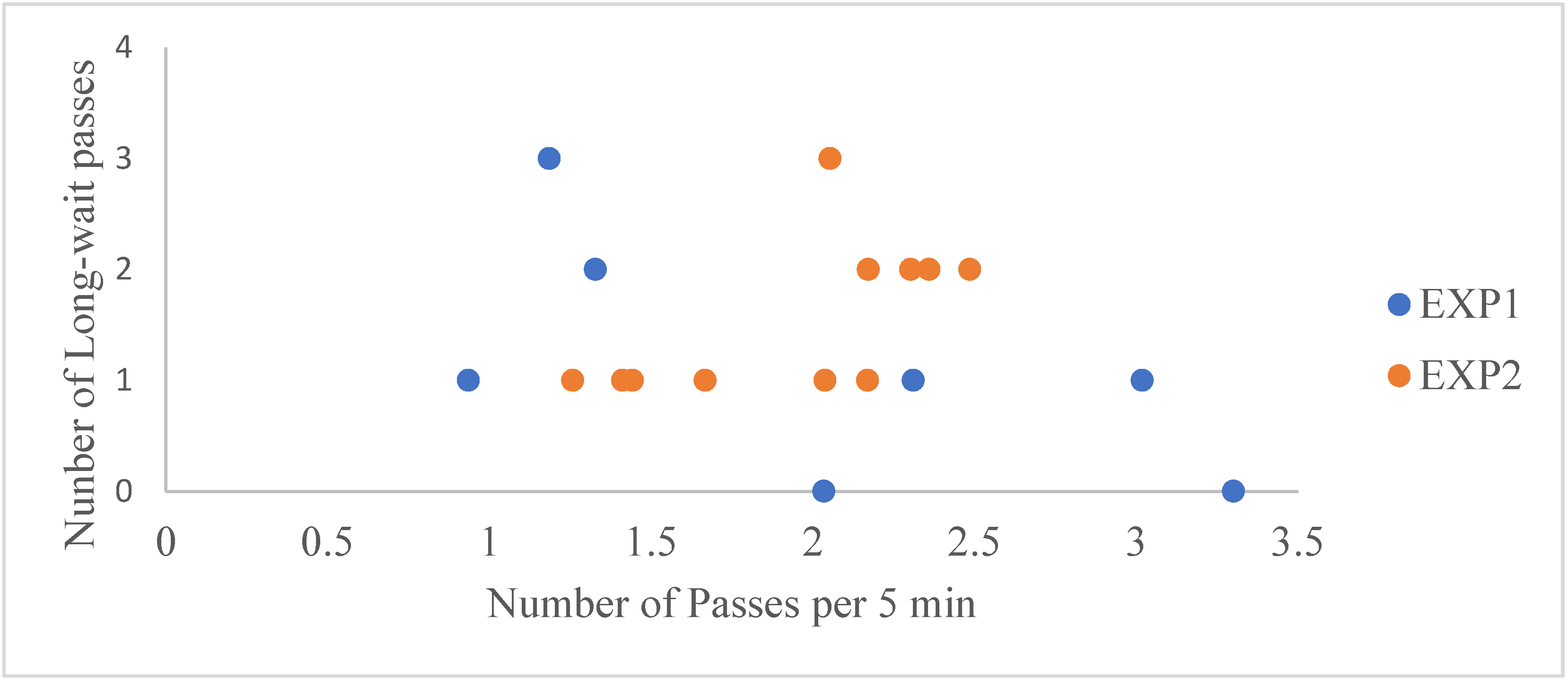
| Scenario 1 | Scenario 2 | |
|---|---|---|
| Follow given route | √ | √ |
| Receive and give out Parcels | √ | √ |
| Switch hats when turning around | X | √ |
| Read sticker on each MEU | X | √ |
| Give out parcels according to hats and stickers | X | √ |
| Pass | LW | Turn | Overlap | ||
|---|---|---|---|---|---|
| Total Count | Exp 1 | 54 | 10 | 30 | 10 |
| 18.5% | 55.6% | 18.5% | |||
| Exp 2 | 72 | 25 | 27 | 11 | |
| 34.7% | 37.5% | 15.3% | |||
| Successful Delivery | Exp 1 | 30 | 8 | 14 | 2 |
| 26.7% | 46.7% | 6.7% | |||
| Exp 2 | 54 | 17 | 19 | 7 | |
| 31.5% | 35.2% | 13.0% |
| No. Delivery | Pass | LW | Turn | Overlap | Time(s) | |
|---|---|---|---|---|---|---|
| Exp 1 | 6 | 5.00 | 1.33 | 2.33 | 0.33 | 852 |
| Exp 2 | 11 | 4.91 | 1.55 | 1.73 | 0.64 | 727 |
| LW | Turn | Overlap | Time(s) | Std. Time(s) | Pass/5 min | |
|---|---|---|---|---|---|---|
| Exp 1 | 26.7% | 46.7% | 6.7% | 170 | 84.7 | 1.76 |
| Exp 2 | 31.5% | 35.2% | 16.7% | 148 | 40.5 | 2.03 |
© 2020 by the authors. Licensee MDPI, Basel, Switzerland. This article is an open access article distributed under the terms and conditions of the Creative Commons Attribution (CC BY) license (http://creativecommons.org/licenses/by/4.0/).
Share and Cite
Lin, X.; Nishiki, Y.; Tavasszy, L.A. Performance and Intrusiveness of Crowdshipping Systems: An Experiment with Commuting Cyclists in The Netherlands. Sustainability 2020, 12, 7208. https://doi.org/10.3390/su12177208
Lin X, Nishiki Y, Tavasszy LA. Performance and Intrusiveness of Crowdshipping Systems: An Experiment with Commuting Cyclists in The Netherlands. Sustainability. 2020; 12(17):7208. https://doi.org/10.3390/su12177208
Chicago/Turabian StyleLin, Xiao, Yoshinari Nishiki, and Lóránt A. Tavasszy. 2020. "Performance and Intrusiveness of Crowdshipping Systems: An Experiment with Commuting Cyclists in The Netherlands" Sustainability 12, no. 17: 7208. https://doi.org/10.3390/su12177208
APA StyleLin, X., Nishiki, Y., & Tavasszy, L. A. (2020). Performance and Intrusiveness of Crowdshipping Systems: An Experiment with Commuting Cyclists in The Netherlands. Sustainability, 12(17), 7208. https://doi.org/10.3390/su12177208




